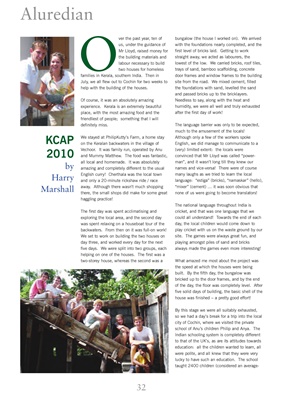
O
ver the past year, ten of
us, under the guidance of
Mr Lloyd, raised money for
the building materials and
labour necessary to build
two houses for homeless
families in Kerala, southern India. Then in
July, we all flew out to Cochin for two weeks to
help with the building of the houses.
Of course, it was an absolutely amazing
experience. Kerala is an extremely beautiful
place, with the most amazing food and the
friendliest of people; something that I will
definitely miss.
We stayed at PhilipKutty's Farm, a home stay
on the Keralan backwaters in the village of
Vechoor. It was family run, operated by Anu
and Mummy Matthew. The food was fantastic,
all local and homemade. It was absolutely
amazing and completely different to the usual
English curry! Cherthala was the local town
and only a 20-minute rickshaw ride / race
away. Although there wasn't much shopping
there, the small shops did make for some great
haggling practice!
The first day was spent acclimatising and
exploring the local area, and the second day
was spent relaxing on a houseboat tour of the
backwaters. From then on it was full-on work!
We set to work on building the two houses on
day three, and worked every day for the next
five days. We were split into two groups, each
helping on one of the houses. The first was a
two-storey house, whereas the second was a
bungalow (the house I worked on). We arrived
with the foundations nearly completed, and the
first level of bricks laid. Getting to work
straight away, we acted as labourers, the
lowest of the low. We carried bricks, roof tiles,
trays of sand, bamboo scaffolding, concrete
door frames and window frames to the building
site from the road. We mixed cement, filled
the foundations with sand, levelled the sand
and passed bricks up to the bricklayers.
Needless to say, along with the heat and
humidity, we were all well and truly exhausted
after the first day of work!
The language barrier was only to be expected,
much to the amusement of the locals!
Although only a few of the workers spoke
English, we did manage to communicate to a
(very) limited extent: the locals were
convinced that Mr Lloyd was called "powerman",
and it wasn't long till they knew our
names and vice-versa! There were of course
many laughs as we tried to learn the local
language: "estiga" (bricks), "namaskar" (hello),
"mixer" (cement) … it was soon obvious that
none of us were going to become translators!
The national language throughout India is
cricket, and that was one language that we
could all understand! Towards the end of each
day, the local children would come down to
play cricket with us on the waste ground by our
site. The games were always great fun, and
playing amongst piles of sand and bricks
always made the games even more interesting!
What amazed me most about the project was
the speed at which the houses were being
built. By the fifth day, the bungalow was
bricked up to the door frames, and by the end
of the day, the floor was completely level. After
five solid days of building, the basic shell of the
house was finished - a pretty good effort!
By this stage we were all suitably exhausted,
so we had a day's break for a trip into the local
city of Cochin, where we visited the private
school of Anu's children Philip and Anya. The
Indian schooling system is completely different
to that of the UK's, as are its attitudes towards
education: all the children wanted to learn, all
were polite, and all knew that they were very
lucky to have such an education. The school
taught 2400 children (considered an averageAluredian
32
KCAP
2010
by
Harry
Marshall